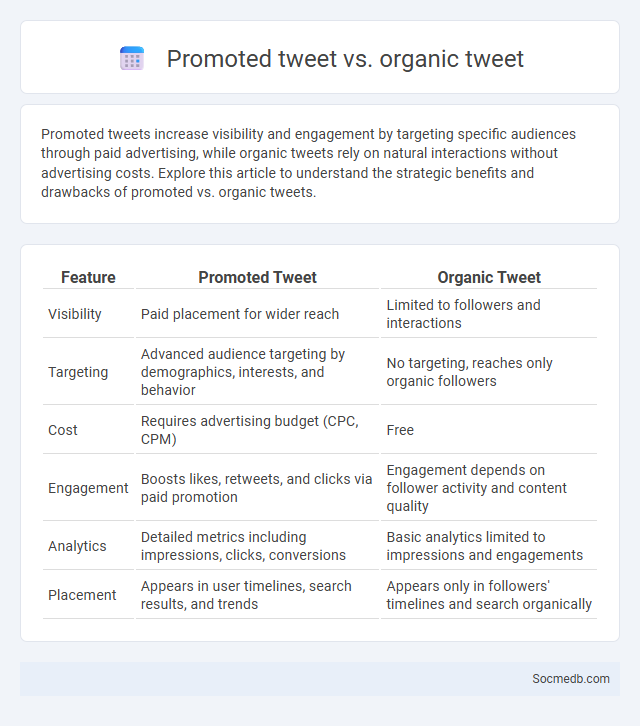
Photo illustration: Promoted tweet vs Organic tweet
Promoted tweets increase visibility and engagement by targeting specific audiences through paid advertising, while organic tweets rely on natural interactions without advertising costs. Explore this article to understand the strategic benefits and drawbacks of promoted vs. organic tweets.
Table of Comparison
| Feature | Promoted Tweet | Organic Tweet |
|---|---|---|
| Visibility | Paid placement for wider reach | Limited to followers and interactions |
| Targeting | Advanced audience targeting by demographics, interests, and behavior | No targeting, reaches only organic followers |
| Cost | Requires advertising budget (CPC, CPM) | Free |
| Engagement | Boosts likes, retweets, and clicks via paid promotion | Engagement depends on follower activity and content quality |
| Analytics | Detailed metrics including impressions, clicks, conversions | Basic analytics limited to impressions and engagements |
| Placement | Appears in user timelines, search results, and trends | Appears only in followers' timelines and search organically |
Introduction to Twitter Marketing
Twitter marketing leverages the platform's real-time engagement to boost brand visibility and connect with a global audience. Crafting concise, impactful tweets with relevant hashtags and multimedia increases your reach and follower interaction. You can monitor trends and analyze performance metrics to refine your content strategy and achieve targeted marketing goals.
Understanding Organic Tweets
Organic tweets generate authentic engagement by leveraging genuine interactions rather than paid promotions, making them essential for building trust and community on platforms like Twitter. Analyzing reach, impressions, and engagement rates of organic tweets provides valuable insights into audience preferences and content effectiveness. Optimizing tweet timing, hashtag relevance, and interaction frequency enhances organic visibility and fosters sustained follower growth.
What Are Promoted Tweets?
Promoted Tweets are paid advertisements on Twitter designed to increase the visibility of your message beyond your regular followers. These tweets appear in users' timelines, search results, and other relevant areas, targeting specific audiences based on demographics, interests, or behavior. By using Promoted Tweets, you can effectively boost engagement, drive traffic, and enhance brand awareness on the platform.
Key Differences: Promoted Tweet vs Organic Tweet
Promoted Tweets are paid advertisements designed to reach a wider audience beyond the account's followers, leveraging targeting options like demographics, interests, and behaviors to maximize engagement and conversions. Organic Tweets, on the other hand, are unpaid posts visible only to an account's existing followers and rely on natural interactions such as likes, retweets, and replies to gain traction. Promoted Tweets offer measurable analytics and priority placement in users' timelines, whereas Organic Tweets depend on content relevance and timing for visibility and audience growth.
Benefits of Using Promoted Tweets
Promoted Tweets enhance brand visibility by targeting specific audiences based on demographics, interests, and behaviors, leading to higher engagement rates. They boost campaign performance with measurable metrics such as click-through rates, impressions, and conversions, enabling precise ROI tracking. Leveraging Twitter's real-time platform, Promoted Tweets facilitate timely interaction during events, amplifying reach and fostering community engagement.
Strengths of Organic Tweets
Organic tweets generate authentic engagement by fostering genuine interactions with followers, enhancing trust and brand loyalty. They leverage real-time communication and trending hashtags to increase visibility without incurring advertising costs. Consistently posting high-quality organic content improves reach through retweets and shares, amplifying brand presence naturally.
Cost Comparison: Promoted vs Organic Tweets
Promoted tweets require a budget allocation, with costs varying based on bidding strategies, targeting options, and campaign duration, often ranging from $0.50 to $4.00 per engagement. Organic tweets, while free to publish, demand consistent effort in content creation and audience engagement to achieve comparable reach and interaction levels. Understanding this cost comparison helps you allocate resources effectively to maximize your social media marketing ROI.
Engagement Rates: Promoted vs Organic Tweets
Engagement rates for promoted tweets typically outperform organic tweets by reaching a broader audience through targeted advertising algorithms, resulting in higher click-throughs, likes, and shares. Organic tweets rely on follower interaction and content virality, which can vary greatly based on post timing, relevance, and community engagement. You can maximize your social media strategy by balancing promoted tweets to boost visibility while maintaining authentic organic content to nurture audience trust and interaction.
When to Use Promoted Tweets Over Organic
Promoted Tweets are ideal for targeting specific demographics or driving immediate engagement, especially during product launches, time-sensitive campaigns, or when expanding brand reach beyond existing followers. Organic Tweets perform well for fostering ongoing relationships, brand personality, and community interaction but lack the precise targeting and guaranteed visibility. Utilizing Promoted Tweets during key campaign moments ensures maximum exposure and optimized ROI compared to relying solely on organic reach.
Best Practices for Combining Promoted and Organic Tweets
Maximizing social media impact requires strategic integration of promoted and organic tweets by maintaining consistent messaging and branding across both formats to reinforce key campaign themes. Employing data-driven insights from Twitter Analytics helps identify high-performing organic content that can be amplified through promotion for increased reach and engagement. Regularly monitoring audience interactions and adjusting targeting parameters enhances the synergy between paid and organic efforts, optimizing overall campaign effectiveness on the Twitter platform.
 socmedb.com
socmedb.com